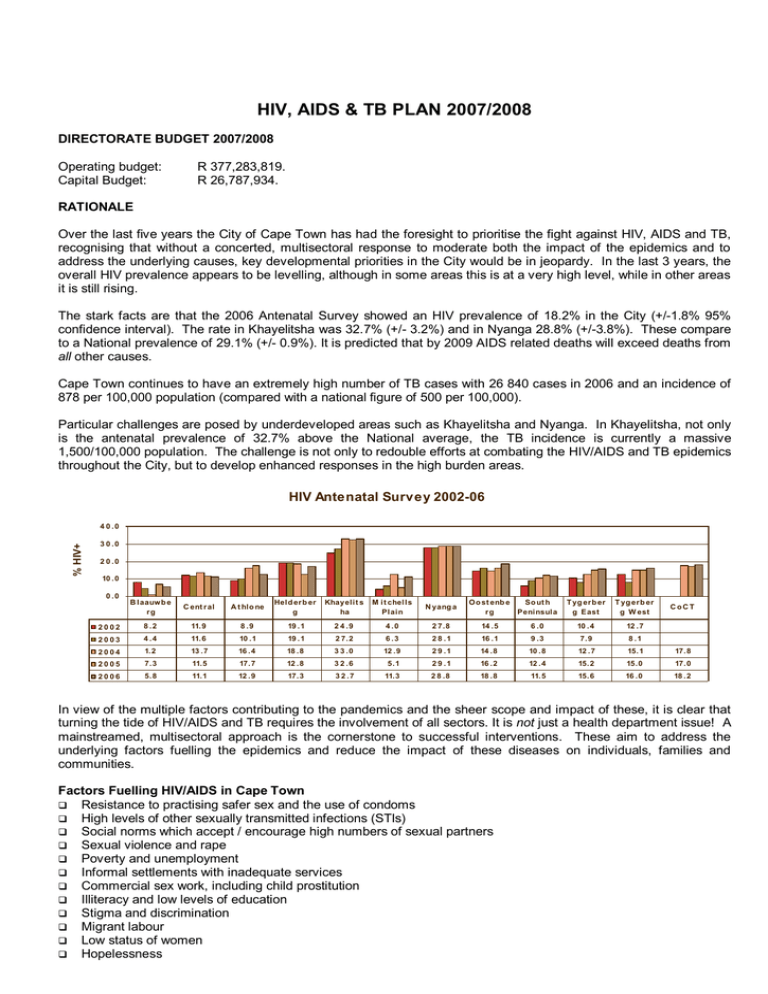
HIV, AIDS & TB PLAN 2007/2008
DIRECTORATE BUDGET 2007/2008
Operating budget:
Capital Budget:
R 377,283,819.
R 26,787,934.
RATIONALE
Over the last five years the City of Cape Town has had the foresight to prioritise the fight against HIV, AIDS and TB,
recognising that without a concerted, multisectoral response to moderate both the impact of the epidemics and to
address the underlying causes, key developmental priorities in the City would be in jeopardy. In the last 3 years, the
overall HIV prevalence appears to be levelling, although in some areas this is at a very high level, while in other areas
it is still rising.
The stark facts are that the 2006 Antenatal Survey showed an HIV prevalence of 18.2% in the City (+/-1.8% 95%
confidence interval). The rate in Khayelitsha was 32.7% (+/- 3.2%) and in Nyanga 28.8% (+/-3.8%). These compare
to a National prevalence of 29.1% (+/- 0.9%). It is predicted that by 2009 AIDS related deaths will exceed deaths from
all other causes.
Cape Town continues to have an extremely high number of TB cases with 26 840 cases in 2006 and an incidence of
878 per 100,000 population (compared with a national figure of 500 per 100,000).
Particular challenges are posed by underdeveloped areas such as Khayelitsha and Nyanga. In Khayelitsha, not only
is the antenatal prevalence of 32.7% above the National average, the TB incidence is currently a massive
1,500/100,000 population. The challenge is not only to redouble efforts at combating the HIV/AIDS and TB epidemics
throughout the City, but to develop enhanced responses in the high burden areas.
HIV Antenatal Survey 2002-06
% HIV+
4 0 .0
3 0 .0
2 0 .0
10 .0
0 .0
B laauwb e
rg
C ent r al
A t hlo ne
Held er b er
g
Khayelit s
ha
M it chells
Plain
N yang a
2002
8 .2
2003
4 .4
2004
Oo st enb e
So ut h
rg
Peninsula
T yg er b er
g East
T yg er b er
g W est
11.9
8 .9
19 .1
2 4 .9
4 .0
2 7.8
14 .5
11.6
10 .1
19 .1
2 7.2
6 .3
2 8 .1
16 .1
6 .0
10 .4
12 .7
9 .3
7.9
1.2
13 .7
16 .4
18 .8
3 3 .0
12 .9
2 9 .1
8 .1
14 .8
10 .8
12 .7
15.1
2005
7.3
11.5
17.7
12 .8
3 2 .6
5.1
2 9 .1
16 .2
12 .4
15.2
15.0
2006
5.8
11.1
12 .9
17.3
3 2 .7
11.3
17.0
2 8 .8
18 .8
11.5
15.6
16 .0
18 .2
CoCT
17.8
In view of the multiple factors contributing to the pandemics and the sheer scope and impact of these, it is clear that
turning the tide of HIV/AIDS and TB requires the involvement of all sectors. It is not just a health department issue! A
mainstreamed, multisectoral approach is the cornerstone to successful interventions. These aim to address the
underlying factors fuelling the epidemics and reduce the impact of these diseases on individuals, families and
communities.
Factors Fuelling HIV/AIDS in Cape Town
Resistance to practising safer sex and the use of condoms
High levels of other sexually transmitted infections (STIs)
Social norms which accept / encourage high numbers of sexual partners
Sexual violence and rape
Poverty and unemployment
Informal settlements with inadequate services
Commercial sex work, including child prostitution
Illiteracy and low levels of education
Stigma and discrimination
Migrant labour
Low status of women
Hopelessness
Factors Fuelling TB in Cape Town
Poverty
Urbanisation with resultant overcrowding
Damp, poorly ventilated houses/shacks
Clients present late to the clinics (infect many others before treatment)
Poor treatment outcomes due to treatment interruption (defaulters)
Substance abuse
Smoking
Legal Requirements
Clinic health services are now the statutory responsibility of the provincial health department as stated in the National
Health Act, No. 61 of 2003. Most sections of the Act came into effect on 2 May 2005.
Vision
To work together with the provincial health department to mainstream a multi-sectoral response that moblises all City
sectors in a developmental intervention to fight HIV/AIDS and TB, thereby reducing the number of new infections
(especially among the youth). We also aim to reduce the impact of HIV/AIDS on individuals, families and communities
and specifically on the Council workforce and reach an 85% cure rate for new smear positive TB cases over the next
5 years.
STRATEGY PLAN
The strategy for HIV & AIDS involves strengthening the prevention, treatment and care components. There is already
a strong emphasis on condom distribution (highest in SA), “GET TESTED” campaign and other prevention
interventions will be driven by a multi sectoral approach within City Health and MDHS. Already strong referral links to
community home based care will grow and the number of clients on anti retoviral treatment will increase. The
proposal is for future expansion of ART Services that will be nurse driven.
With respect to TB the two key objectives are to jointly increase case finding (particularly at provincial facilities) and to
improve the new smear positive cure rate.
The most important tasks at hand include:
Mainstreaming HIV, AIDS and TB
Mitigating the Social, Economic and Human Impact
Prevention
Treatment
Workplace Programme
MAINSTREAMING HIV, AIDS & TB
The City HIV/AIDS and TB Coordinating Committee, chaired by the Mayoral Committee Member for Health
coordinates the multisectoral response. The committee brings together on a monthly basis representatives of political
parties, relevant directorates, unions, the sub district Multi-Sectoral Action Teams (MSATs), the provincial
interdepartmental AIDS Committee and Provincial department of Social Services. The function of the committee is to
drive the mainstreaming of HIV, AIDS & TB and:
Coordinate the City‟s multisectoral plan, both external and internal (workplace)
Facilitate development of sector plans
Hold directorates accountable for delivery
Monitor overall delivery to ensure no duplication / wastage
Lobby and advocate so as to make resources available
Create an enabling environment to operationalise sub-district plans
Quarterly presentations to EMT to hold departments accountable.
Indicator/Target for 2007/2008
Departmental plans have been implemented and are being monitored by the HIV/AIDS Coordinating Committee
for the following sectors: Health; Human Resource Management and Development; Sport and Recreation;
Libraries & Information; Economic, Social Development and Tourism; City Parks; Development Services;
Communications; Finance; Housing; and other Departments are still developing plans.
MITIGATING THE SOCIAL, ECONOMIC AND HUMAN IMPACT
Multi-Sectoral Action Teams (MSATs) have been established in each of the eight sub-districts. These bring together
all the local stakeholders involved in HIV, AIDS & TB – non governmental organisations (NGOs), community based
organisations (CBOs), local business, faith based organizations, local officials, councillors and sub-council managers
so as to develop and drive a co-ordinated plan that addresses local needs. This entails the mobilisation of
communities, participation of key stakeholders, encouraging volunteerism, the development and funding of projects
that address local needs.
Indicator/Target for 2007/2008
60 NGO and CBO projects funded & monitored.
PREVENTION
Preventing new HIV infections remains a priority. The focus is on the ABC of prevention: Abstain, Be faithful to one
partner or if having multiple sexual partners or if HIV-positive, to always use a Condom. Thirty-three million condoms
will be distributed through clinics, libraries, community facilities and all Council offices together with appropriate
educational material on the ABC of prevention. The City will continue to participate in the Prevention of Mother to
Child Transmission Programme through the follow up of mothers and babies at City clinics and the provision of free
milk formula. The management of concurrent sexually transmitted infections will be improved, as this is a key driver of
HIV infection. Prevention efforts in communities will be strengthened through clinic outreach activities and consistent
messages from political leaders. City Health launched the „Get Tested‟ campaign on World AIDS Day (01 December
2006). Sub Districts are organising a community outreach every quarter.
Indicator/Targets for 2007/2008
55 condoms per male >15 per year distributed
10% of adult population tested for HIV
60% of STI clients tested for HIV
STI partner treatment rate of 21%
Undertake 344 clinic outreach activities to communities
TREATMENT
The strong partnership between City and Province in the provision of antiretroviral treatment (ART) has allowed for
additional sites at City clinics as well as Provincial CHC‟s and combined facilities to be established to provide for the
increasing need. As at the end of June 2007 the City is providing ART at Chapel St, as part of a workplace
programme for HIV positive staff, and at 8 clinics:
Hout Bay Main Road
Langa
DuNoon
Ikhwezi
Albow Gardens
Mathew Goniwe
Kuyasa
Wallacedene
The City provides a comprehensive treatment programme which includes:
Psychosocial support: clinical psychologist one on one sessions and support groups
Nutritional support
Provision of reproductive health services and management of STI‟s
Prevention and treatment of opportunistic infections, including TB
Screening and referral or on site provision of ART (at specified sites)
Referral to NGO‟s and CBO‟s for home based care
A pilot patient advocate programme as community based support for adherence
Indicator/Targets for 2007/2008
4,683 clients on ART by end June 2008
1 Workplace programme site and 10 clinic based sites providing ART
TB cure rate of 76% for smear positive TB cases
CRITICAL SUCCESS FACTORS/RISKS/DEPENDANCIES
Adequate staffing in clinics
Continued Global funding to MSAT partnerships
Provincial funding for an enhanced TB response
WORKPLACE PROGRAMME
It is estimated that 10.4% of the workforce is HIV+. The goal is to limit and manage the impact of the HIV epidemic on
the City‟s internal workforce. This programme is seen as best practice throughout South Africa by the SA Cities
Network and focuses on:
o
Awareness Training through peer educators; talks and workshops and condom distribution at offices and depots
o
Voluntary counselling and testing of staff at all occupational health clinics and other non-clinical sites.
o
Care and support of staff through quality counselling and support groups with staff supported and encouraged to
disclose their HIV status so as to reduce stigma.
o
Treatment of those staff (and partners and children) not covered by medical aid (or whose medical aid is
exhausted).
Targets for 2007/2008
o
o
o
12 programmes to promote VCT
16,000 staff reached through peer education workshops
1,800 staff accessing VCT service
PARTNERSHIPS
The major partnership is with the Provincial Health Department so that we together offer a coordinated
comprehensive health sector response. The other key partnership is with NGOs and CBOs at a local level who join
the local MSAT and may develop a local project to impact on the epidemic. These projects are then funded by the
City using Global fund resources.







